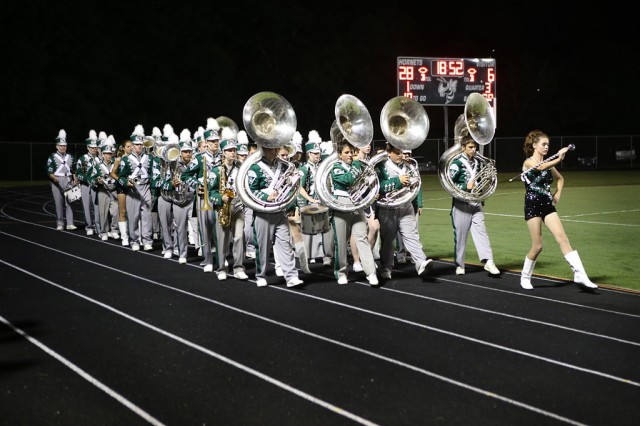Military-Style Bands Fighting March to Obscurity

Hemphill’s Little Green Band, one of the surviving military marching bands in Texas, prepares for a halftime performance. Photo by Jeremy Thomas/Reporting Texas
By Jeremy Thomas
For Reporting Texas
Iron-pressed slacks and shiny white shoes march forward in sequence across straight or diagonal rows and columns.
The marchers stand upright in regalia patterned after 19th-century military uniforms, with epaulettes on their shoulders and belts forming an “X” across their torsos.
Every turn – quickly snapped. Every musical note – precise.
But Texas marching bands are taking a sharp turn away from the military-style performances that were once a staple during Texas high school football halftime performances.
Fewer than 80 of Texas’ nearly 1,400 high schools have military-style bands, a dramatic decline from the height of their popularity from the 1950s to the 1970s.
Most schools march “corps-style.” In addition to marching in straight lines, they form different shapes on the field by changing step sizes to create curves.
Despite their dwindling numbers, military marching bands continue to fight to preserve their traditions. They also want more recognition: a state championship of their own. Military and corps-style bands currently compete against one another at the University Interscholastic League marching band contest.
“If you called ‘corps’ bands apples, you would call ‘military’ bands oranges, and you can’t compare the two,” said Nick Durham, band director for Carthage High School in East Texas and the president of the National Association of Military Marching Bands.
Corps-style bands use props, costumes and a variety of music – from pop to rap to film scores. Military-style bands typically play traditional march music at a heart-pounding tempo of 120 to 140 beats per minute and maneuver on the field with sharp, stiff turns.
Since the 1970s, the creation of lighter drums and competitions such as Drums Corps International helped popularize corps-style bands. Military-style bands have no similar organizations or competitions at the national or worldwide level.
Enthusiasts of the military-style bands promise to keep pushing for a separate championship. A state UIL contest for military-style bands would help sustain them, according to association officials.
“More people would realize military is a credible way of marching,” Durham said. “The letters U-I-L make a big difference to superintendents and the school board. We think that cementing our future in UIL would cement our future for good.”
In December 2013, association members approached UIL executives in Texas about creating a separate contest for military bands.
Two UIL music committees recently rejected the military marching band association’s proposal, according to UIL music director Bradley Kent. UIL officials cited the lack of state championships for other band styles and the vanishing footprint of military-style bands.
“The proposal received due process,” Kent said. The UIL “heard all angles, heard the discussion and rejected the proposal.”
The lack of participation from military bands in statewide marching competitions also played a major role in why the committees rejected the proposal, said Kathy Johnson, director of four-time state champion Argyle High School corps-style band.
This year, 26 military-style bands competed in the military marching band association’s statewide competition, its only annual event.
The Overton High School Marching Band was the last military band to win a state championship in any UIL conference. That was in 2001. The highest any military band has placed since then is third: Hemphill High in 2003 and New Boston High in 2007.
Military marching bands still have deep roots in East Texas and the Golden Triangle area near Beaumont, where community support helps to uphold the tradition.
Over the years, many Texas high school bands switched from military-style to corps-style. New high schools frequently have opted for corps-style bands.
Last spring, Scott Tyner set out to restore the roar in Tenaha High School’s Roar’in Band in East Texas. The Tenaha schools superintendent hired a corps-style band director to reinvent the longstanding military-style band.
Marching to a different step, the band received top marks at this year’s 2014 UIL Regional Marching Contest. It was Tenaha’s first “superior” rating since 2011.
“To me, the style doesn’t matter,” Tyner said. “But if your goal is to be competitive at the state level, then you are selling your program short of opportunities by staying military.”
Durham, in his sixth year as band director at Carthage High, said the military marching band association will revise and resubmit their proposal to the UIL next year.
“We’re gonna try like hell to keep our style alive, and it’s not easy,” Durham said. “We’re gonna try like hell to make sure the UIL gets us a place on UIL state stage that will help keep us alive. … Not only would we sustain the current military bands that we have, but we also think that would grow.
“That’s very important — not only keeping what we have, but growing,” he added.